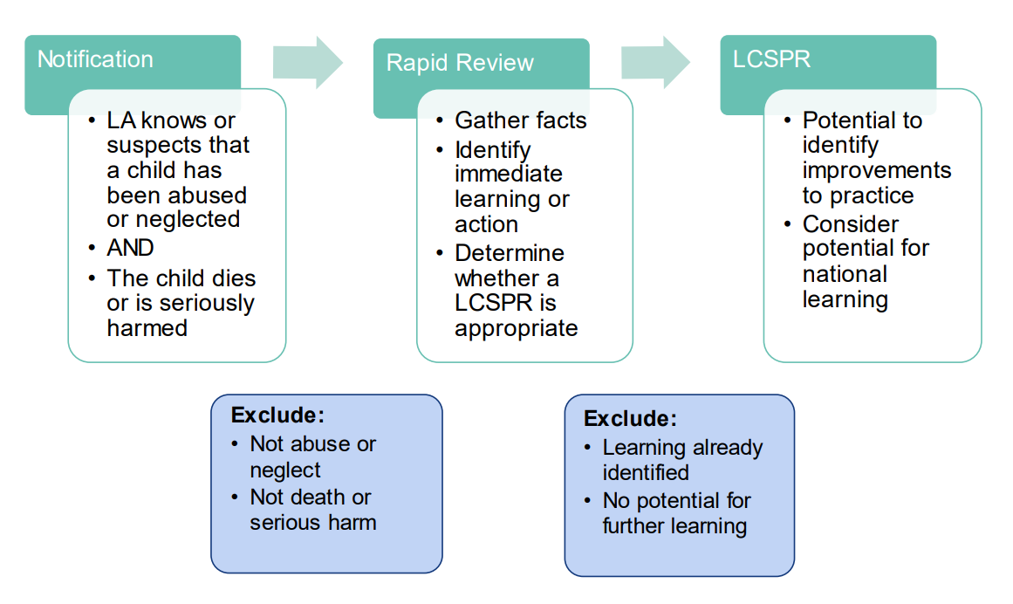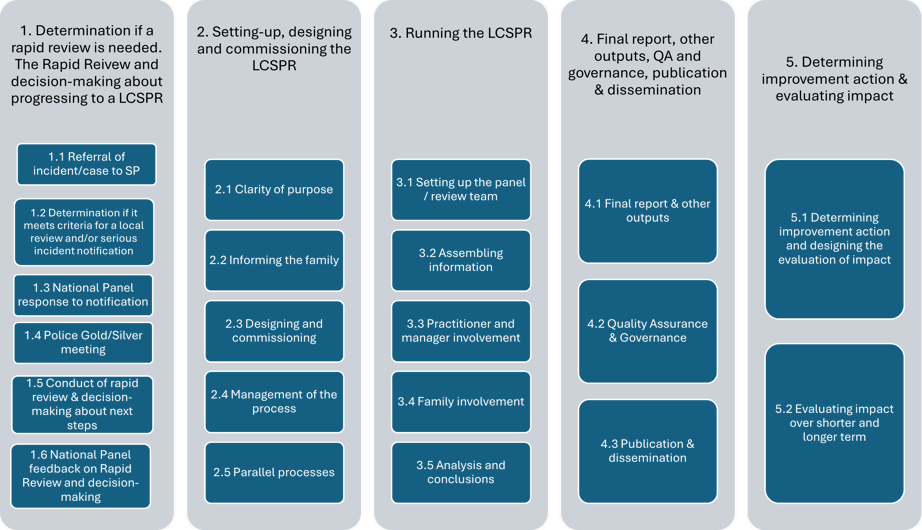Making the Local Practice Review Process clearer for everyone
Introduction
In this briefing we talk about why and how the Child Safeguarding Practice Review Panel (CSPRP) Learning Support Project is mapping the Local Child Safeguarding Practice Review (LCSPR) process.
The aim of Local Child Safeguarding Practice Review (LCSPR) process is to identify improvements that can safeguard and promote the welfare of children. Reflecting on the process for identifying and drawing out what needs to improve is therefore critical. Commissioned by the Child Safeguarding Practice Review Panel (the panel), the CSPRP Learning Support project aims to explore:
-
What we know about the value and quality of LCSPRs.
-
Processes for conducting high quality reviews.
-
Making the most of opportunities for live learning in the review process.
The Panel intend to use the findings from the project to help safeguarding partnerships improve LCSPRs.
Learning so far

Early on, the collaborative project team started to realise that the LCSPR ‘process’ wasn’t clear enough to any of us. Partners across the ten safeguarding partnerships involved in the project also talked about lack of clarity and told us that it would be useful to have the simple materials to explain the LCSPR process to different agencies, to families and practitioners. They also told us they want to be able to learn from other areas and understand what ‘good’ looks like and see how their approach compares.
Despite being an inter-disciplinary project team with extensive relevant knowledge, we had no common points of reference for the basics of conducting a review, its constituent parts, its start and finish points. Differences between project team members’ backgrounds and starting points (as independent reviewers, researchers, social workers and policing professionals) came through. While some of these different perspectives were uncomfortable at first, it seemed entirely possible that the project team was mirroring different perspectives and levels of knowledge in the wider system. We started to ask:
- With whom does a detailed understanding of the LCSPR process sit? Is it safeguarding partnerships’ Business Managers or more widely across partners?
- How is clarity established, given that there is no induction for professionals into multi-agency LCSPRs?
- Were people with experience of conducting these reviews more familiar with the process than others?
Our aims
Having established that there was no ready resource that we could all reference, we decided to create a ‘Process Map’ with the aim to:
-
Create a generic framework for the CSPRP Learning Support team to use in gathering fieldwork data. This should make it easier to ask partners how they approach reviews and to compare different areas. We can benchmark where it’s working well, where the challenges are, and at which points in the process partnerships would like more clarity, guidance or support.
- Invite safeguarding partnerships to add to it as we talk together about their approach and areas for support. Through testing the process map in dialogue with safeguarding partnerships we anticipate that it will mature to reflect a collective understanding of:
- What happens at different points in the process.
- Who’s involved in decisions and who’s left out.
- What’s clear and transparent and where are things unclear.
- The extent to which the policy framework is helpful.
We’re talking to partners, independent reviewers, policy makers and leaders. We hope to hear your perspectives about what’s involved in the process too.
Questions about the actions and steps included in the Local Practice Review Process
A primary step for the CSPRP Learning Support project was to undertake rapid evidence review to establish ‘how much we know’ about improving the process and about what constitutes a ‘high quality review’. We found that there is more focus in the literature on the end of the process: the implementation of recommendations from reports. There has been less exploration of the wider learning that takes place throughout the review process. It started to raise questions about what actions should be considered as part of the review process. For example:
- What learning takes place around the time of a serious incident or death?
- Whether the process (not just the outputs) of the LCSPR is considered and operationalised as a learning opportunity?
We noticed that previous work to improve the process and quality of reviews - the LiPP project (NSPCC/SCIE, 2016), which developed quality markers relating to the SCR process – is now out of date with changes in the policy framework (such as both Working Together 2018 and 2023).
What does the policy framework say about the process?
Certain aspects of the full LCSPR process are covered in the Children and Social Work Act 2017, and in Working Together (2023). But, other than individual partnerships’ varied procedures, it’s not written down in one place.
Since (at least) Working Together (2015), there has in fact been very little prescription of the process for statutory reviews involving child safeguarding. Department for Education has only ever prescribed principles, such as the importance of the independence of reviewers, but no detailed model or process through which a review must be conducted has been articulated.

A range of decision points
The CSPRP guidance for safeguarding partners outlines three key stages in the LCSPR process of learning from serious cases. Figure 1, illustrates the new range of decision-making points these stages introduced:
- Potential reasons for not progressing with either a rapid review or from a rapid review to a LCSPR are captured in the boxes labelled ‘exclude’. Safeguarding partners may also choose to progress a rapid review and LCSPR on a serious child safeguarding case that does not meet the criteria for serious incident notification but does raise issues of importance to the local area.
- Where any further learning activity is determined to be needed, operationalising this learning should always be labelled as a LCSPR, regardless of the approach, or scope of activity.

Including decision-making around serious incident notification and Rapid Reviews
In the context of these early stages we’re exploring with partnerships:
- How and why partnerships progress from a serious incident notification to Rapid Reviews through to LCSPRs?
- Is there a consistent approach and understanding of when and for what reasons to progress to a LCSPR?
- How is potential for learning of ‘national importance’ determined?
- What are the roles and influences of different agencies at these early stages?
We are holding sector specific focus groups which are shedding light on different levels of confidence and involvement in decision-making at these three early stages. In some areas, we’re hearing that local authorities ‘own’ the criteria, and are therefore the primary decision-makers as to whether a serious incident notification or rapid review is required.
The views and experiences of different partner agencies, and who has a seat at the decision-making table, takes on renewed pertinence with Working Together (2023). It is recommended that Lead Safeguarding Partners (heads of each statutory safeguarding partner agency) have a representative from the education sector present at strategic discussions. More widely, there should be close partnership working and engagement with education (at strategic and operational level).
The LCSPR Process Map is arranged around five broad stages:
-
Determination if a rapid review is needed, the Rapid Review and decision-making about progressing to a LCSPR.
-
Set-up, design and commissioning the LCSPR.
-
Running the LCSPR.
-
Final report, other outputs, quality assurance and governance, publication and dissemination.
-
Determining improvement action and evaluating impact.

Figure 2, set outs key elements at each of the five stages, each of these will require a good deal of detailed planning and activity. Some steps (such as quality assurance and governance) are not strictly sequential but are relevant at a number of points or run throughout a review process.
Identifying what ‘good’ looks like
In addition to the summary graphic, we have also developed a more detailed table to help us as a project team to think more deeply about each stage or aspect. We’re sharing the Process Map with safeguarding partnerships in the project to support our conversations about:
- What’s happening at these different stages?
- What’s driving improvements and learning?
- What do we know about what ‘good’ looks like and how to enable it at each stage?
A framework for collaboration
The Process Map is a tool through which we can pursue different lines of enquiry, and a common structure to organise what we learn about how safeguarding partners are conducting reviews. Our hope is that it will become a richer resource over the lifetime of the project as it is refined and extended to reflect the realities of safeguarding partnerships.
What takes place in your local partnership?
Initial feedback indicates partners are finding it useful to enable clarity and confidence about the process. We would like to hear your thoughts:
Is this summary map a good representation of the process as it takes place in your local partnership?
To talk to us about the project, or hear about opportunities to get involved, contact: projectsupport@researchinpractice.org.uk.
We will be sharing learning and reflections over the coming months in a series of blogs, videos and briefings.
The project is delivered by Research in Practice in partnership with the University of East Anglia and Vulnerability, Knowledge and Practice Programme.



